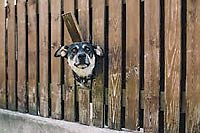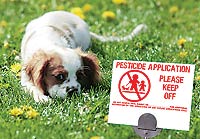The winter is over at last. You can finally get outside, start working in your yard, and begin enjoying your garden again. Your dog is probably just as happy as you are about being outside. But as you retrieve your gardening tools and supplies, there are suddenly all kinds of hidden dangers in your backyard, waiting to hurt your dog. Do you know which items in your backyard can be hazardous or even poisonous to your pet? And do you know how to make sure your dog is safe when spending time outside?
Your Fence
Your fence is supposed to keep your dog safe, but some types of fences can actually be dangerous for dogs. Although fences are necessary, so-called “invisible” fences can be painful for your dog. And electric shock fences can also malfunction, resulting in burns or electrocution.
But a more standard kind of fence can also be dangerous for your dog, some dogs dig under or chew through fences. That can result in injuries for your dog and, obviously, your dog escaping. The solution? Make sure your fence goes at least 6 inches deep. Use mesh to line a fence that your dog wants to chew through. And most importantly, don’t leave your dog unattended in a fenced yard for hours on end.
Sticks
Dog owners might think it’s harmless for their animals to play fetch with sticks. But that assumption couldn’t get further from the truth. According to veterinarians, playing with sticks can cause all kinds of injuries. Your dog can get a splinter in their tongue and in the worst-case scenario, a stick could pierce your dog’s tongue, or a piece of the stick could injure a vital organ if they swallow it. A dog can even impale themselves on a particularly sharp stick. Sure, dog toys can get expensive, but they’re a much safer alternative to sticks when you want to play with your dog.
Grills and Fire Pits
You wouldn’t fire up the grill or start a bonfire in the backyard if you weren’t confident any small children in the vicinity would stay at a safe distance. You should also proceed cautiously if you have a dog in your backyard. A grill with burgers or hot dogs on it will probably smell pretty tempting to your dog. So you’ll need to keep a close eye to protect him from getting burned. The same goes for a fire pit, particles in wood smoke can get in your eyes and respiratory system. You know the dangers. But your dog doesn’t. So make sure you look out for his safety the next time you have a fire in the backyard.
Fertilizers
A good fertilizer helps your lawn and all of the other plants in your backyard grow, but most types of fertilizer pose at least some level of danger to your dog. Most fertilizers contain nitrogen, phosphorous, and potassium in concentrations strong enough that they can cause gastrointestinal irritation in your dog. Nitrogen can even burn the pads of your dog’s paws. Some fertilizer manufacturers offer products that are “safe” for dogs. But even those products can still contain compounds that will hurt your dog. You should keep your dog off treated grass for at least 24 hours or forego the fertilizer.
Organic Fertilizers
It’s not just the standard commercial fertilizers that can harm your dog. Organic alternatives can be toxic to your dog, too. Bone meal and blood meal, both organic compounds that gardeners use to naturally increase the nitrogen content of their soil can be just as poisonous as commercial alternatives. Your dog might like the taste of these fertilizers, but they can do some serious damage. Blood meal can cause vomiting, diarrhea, and severe pancreatitis. And bone meal ingested in large amounts forms a large cement-like bowling ball foreign body in the stomach, which can cause an obstruction in the gastrointestinal tract resulting in possible surgery to remove it.
Compost Piles
Composting offers an attractive alternative to buying commercial or organic fertilizers. Your compost bin or pile can be toxic to your dog. The reason why? These piles of decomposing and decaying organic matter and molding food products have the potential to contain tremorgenic mycotoxins, which are toxic to both pets and wildlife. Make sure your compost bin is secure or your compost pile is appropriately fenced off. And be sure you don’t compost any dairy or meat products.
Herbicides
Herbicides, or the chemicals you use to kill weeds and control unwanted plants in your yard, can be extremely dangerous to your dog. In fact, a study in the 1990s linked herbicides to lymphatic cancer in dogs and the chemicals also increase your dog’s risk of developing bladder cancer. Your dog can be exposed to these chemicals even if you don’t use them, but your neighbor does. Plus, your dog can track the chemicals into your house, where you and your children can come into contact with them.
Insecticides and Pesticides
Products that help control insect populations and other pests are also unsafe for your dog. Exposure to insecticides, even those that control fleas and ticks, can be toxic to dogs. Poisoning can cause symptoms, ranging from fever and diarrhea to seizures and respiratory failure. The Pet Poison Helpline notes most pesticides and insecticides function as basic irritants to dogs. Most don’t pose a huge poisoning concern unless your dog directly ingests the product. However, some kinds of pesticides can react with other chemicals and are life-threatening for your dog to consume.
Flowers and Ornamental Plants
Every gardener who’s also a dog lover knows some plants are dangerous to dogs. Some common plants to watch out for are American holly, azaleas, begonias, boxwood, buttercups, chrysanthemums, daffodils, dahlias, daisies, elephant ears, and English ivy.
Mulch
Many gardeners use mulch to keep weeds under control, but you might want to think twice about your annual mulch delivery if you’ve added a furry friend to your family. Many dogs like to chew on and even eat mulch, but that can be pretty dangerous. Cocoa mulch, specifically, contains an ingredient called theobromine. The compound smells great to your dog but is toxic to them. Other types of mulch, such as those made from pine, cedar, and hemlock, are less toxic to dogs. But they still pose a choking hazard. Dogs can also have an allergic reaction to mulch. So you should always supervise your dog carefully.
Mushrooms
You probably don’t go out of your way to cultivate fungi in your backyard, but you might not do anything about them when you see mushrooms popping up, either. You’ll definitely need to be vigilant if mushrooms tend to grow in the parts of your yard that your dog can access. Mushrooms are a common hazard for dogs. Of course, there are many different kinds of mushrooms; some contain more toxins, or more dangerous toxins, than others. Your dog’s symptoms will depend on the kind of mushrooms he eats and how much he eats. But when you spot mushrooms in the yard, you should remove them!
|